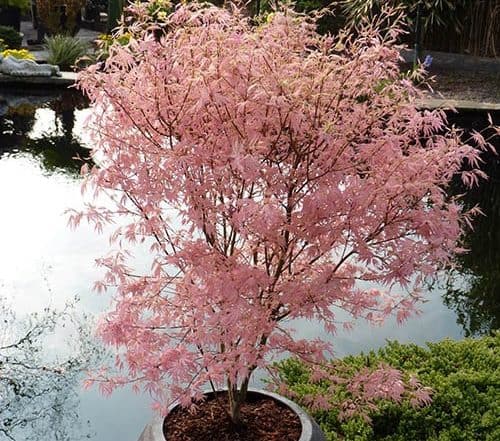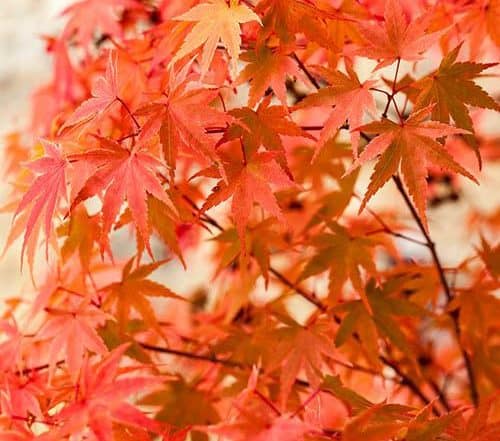The simple answer is yes, they do!
The natural loss of acers losing their leaves

Acer palmatum Orange Dream – Special Japanese Maple
Although Acer Palmatum are known as some of the most elegant maples, they are also very much known for shedding their leaves. Like many deciduous trees, Acers shed their leaves as an active process to conserve nutrients and protect them from being blown over when the weather is extremely windy. This process is guided by a plant hormone identified as auxin.
These attractive trees usually lose most of their leaves in autumn shortly after they start to change colour. They continue to shed in winter, so their branches are bare by the middle of the season. During this period, the tree may look dead from afar but on close inspection, you are likely to notice little buds.
These buds are like a ray of hope letting you know the plant is will regenerate in spring.
The pathologic loss of acers losing their leaves
It is important to note that Acers being a deciduous tree is not the only reason why they lose their leaves. Abnormal shedding may occur if it is exposed to too much sun with a lack of sufficient water.
At this point, the foliage will start to burn which will cause it to fall off eventually. This is otherwise known as acer leaf scorch. Because Acer trees are highly susceptible to harsh weather, it is important to grow them in sheltered locations where some sunlight and rain may penetrate while they remain somewhat protected. While it is situated in partial shade, you may add a layer of mulch at its base to further preserve it.
Acer trees may rarely be affected by cryptogamic diseases which can also cause leaf loss. These are diseases typically caused by cryptograms such as algae, mosses, ferns, and lichens but they may also be caused by organisms classified as fungi and bacteria.
One of the most common of these diseases is verticilliosis which is a disease that hinders the flow of sap through the tree trunk and branches. This is why it is of utmost importance to routinely inspect your Acer tree.
Once the affected branches are identified, they must be taken out so a biological treatment can be carried out. To prevent this from reoccurring, it will be of great benefit to ensure that the substrate of the Acer tree is well-drained.
Further Reading
We have lots of other helpful content for Acers, such as common questions we have been asked such as:
- What should I plant with an acer?
- How is best to repot an acer tree?
- Do Acers prefer acid soil?
- Do Acers prefer ericaceous compost?
- When is best to prune Acer trees in the UK?
- How to take cuttings from acer trees?
- Do Acers lose their leaves?
- Acer leaf browning and diseases,
Other Acer’s you might be interested in
Acer Brilliantissimum, Acer Feeds, Acer Jerre Schwartz, Acer Altropurprueum, Acer beni maiko, Acer Bi Hoo, Acer Bloodgood, Acer bonsai, Acer Butterfly, Acer Deshojo, Acer dissectum, Acer dissectum Firecracker, Acer emerald lace, Acer fireglow, Acer garnet, Acer katsura, Acer little princess, Acer orange dream, Acer Osakazuki, Acer Phoenix, Acer Sango kaku, Acer Seiryu, Acer Shaina, Acer Shindehojo, Acer Skeeters Broom, Acer Taylor, Acer Trompenburg, Acer Ukigumo.









